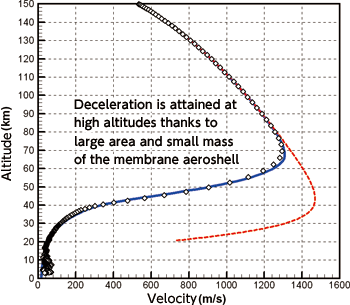TOP > Report & Column > The Forefront of Space Science > 2012 > Towards Realization of a Soft Atmospheric Entry Vehicle
![]()

Midterm examination by sounding-rocket experiment In August 2012, an atmospheric-entry demonstration of the flexible aeroshell was performed by the sounding rocket S-310-41. The experiment was to be the important millstone of our research and development until that time. The test was very important because it covered almost every element necessary for actual application of the atmospheric-entry vehicle in the future. The test included, for example: method to stow the aeroshell compactly; technique to deploy it reliably in a weightless, high-vacuum environment; mechanism to release the experimental vehicle from the rocket; shape design to stabilize the vehicle's attitude by aerodynamic force during atmospheric entry; selection of surface-membrane material capable of withstanding aerodynamic heating at atmospheric entry; outer-frame design capable of withstanding aerodynamic force during flight; and accurate determination of landing/splashing location via satellite communication. The short, approx. 25-minute flight duration of the sounding rocket test is a quick judgment on our long-term efforts, i.e., whether our design is appropriate or not. In a sense, it is just like midterm exam of our development. Fig. 3 shows the vehicle's reentry trajectory, the most important data in the experiment. Horizontal axis is velocity and vertical axis is altitude. Symbols are actual flight data while the blue line is the predicted trajectory. The flight data and the predicted trajectory agree well, indicating that the aeroshell performed deceleration as expected. In the meantime, the red line shows the forecast trajectory in the case of no use of flexible aeroshell (i.e., conventional atmospheric-entry vehicle). By comparison, we find that the flexible aeroshell decelerated more in the higher altitude as predicted. We believe that aerodynamic heating is significantly relaxed by the efficient deceleration at the early stage of atmospheric entry and thus we demonstrated the ability of the new atmospheric-entry vehicle. From this result, we are sure that we passed the examination. 
Conclusion We were able to substantiate what we dreamed. So, what are the applications for it? Since the shape is just like a folding umbrella, it may be a good idea to create a Mars explorer by using a penetrator (spear-shaped probe hitting the ground at high speed and going underground) as the central core. Forgetting about the common-sense rule that an "atmospheric-entry vehicle must have strong and rigid skin to survive," various alternatives are now possible. For this research and development, we received not only the subsidy for strategic research by the JAXA Space Engineering Committee since FY2005 but also support and encouragement from many people of the Research and Operation Office for Scientific Ballooning and Research and Operation Office for Sounding Rocket of ISAS. Taking this opportunity, we would like to express our sincere gratitude to everyone and continue our research and development so that we can be complimented with, "that shiitake-mushroom type is good for atmospheric entry." Kojiro SUZUKI, Kazuhiko YAMADA
|
||||||




